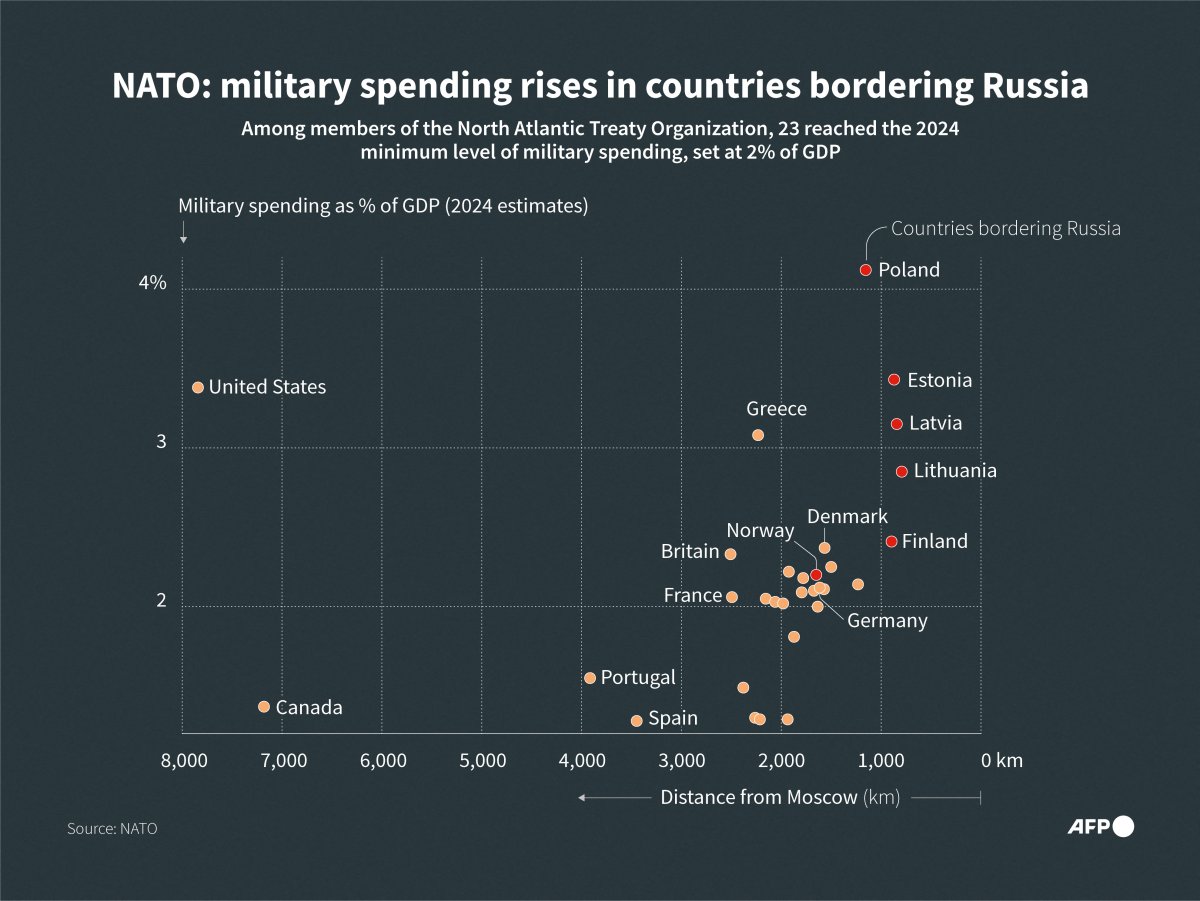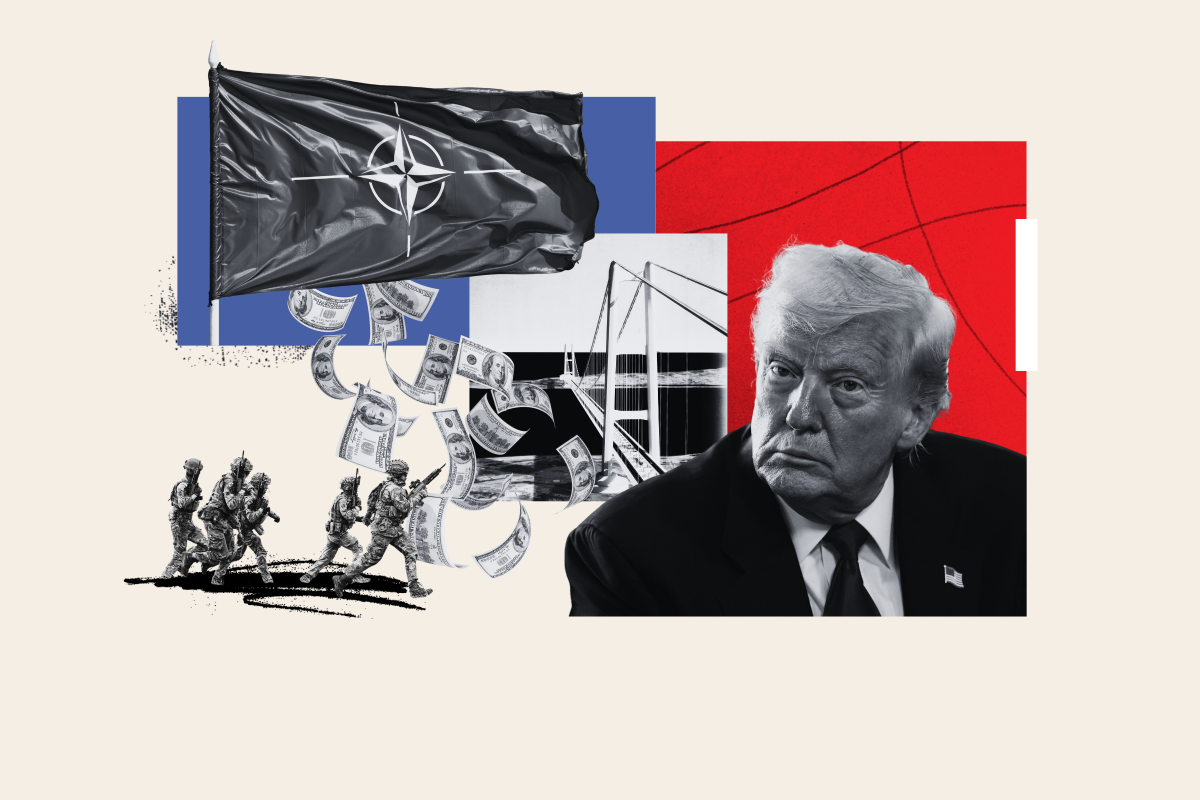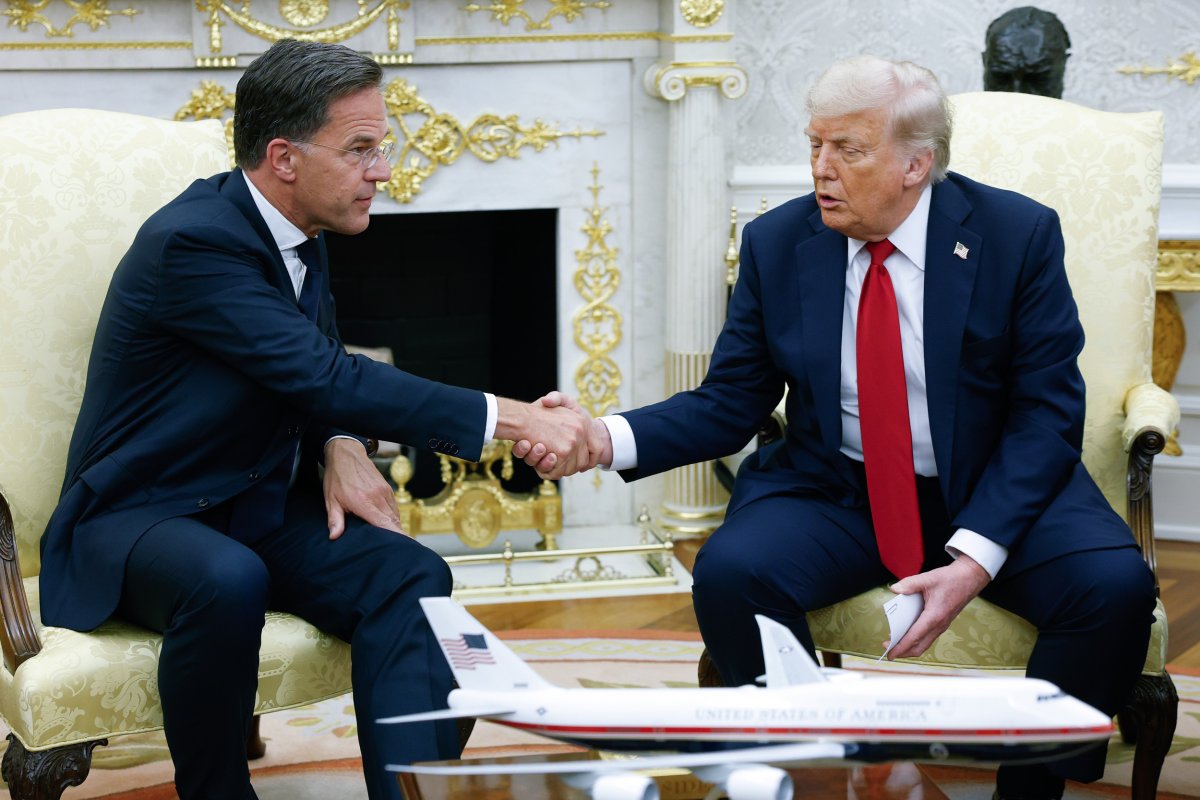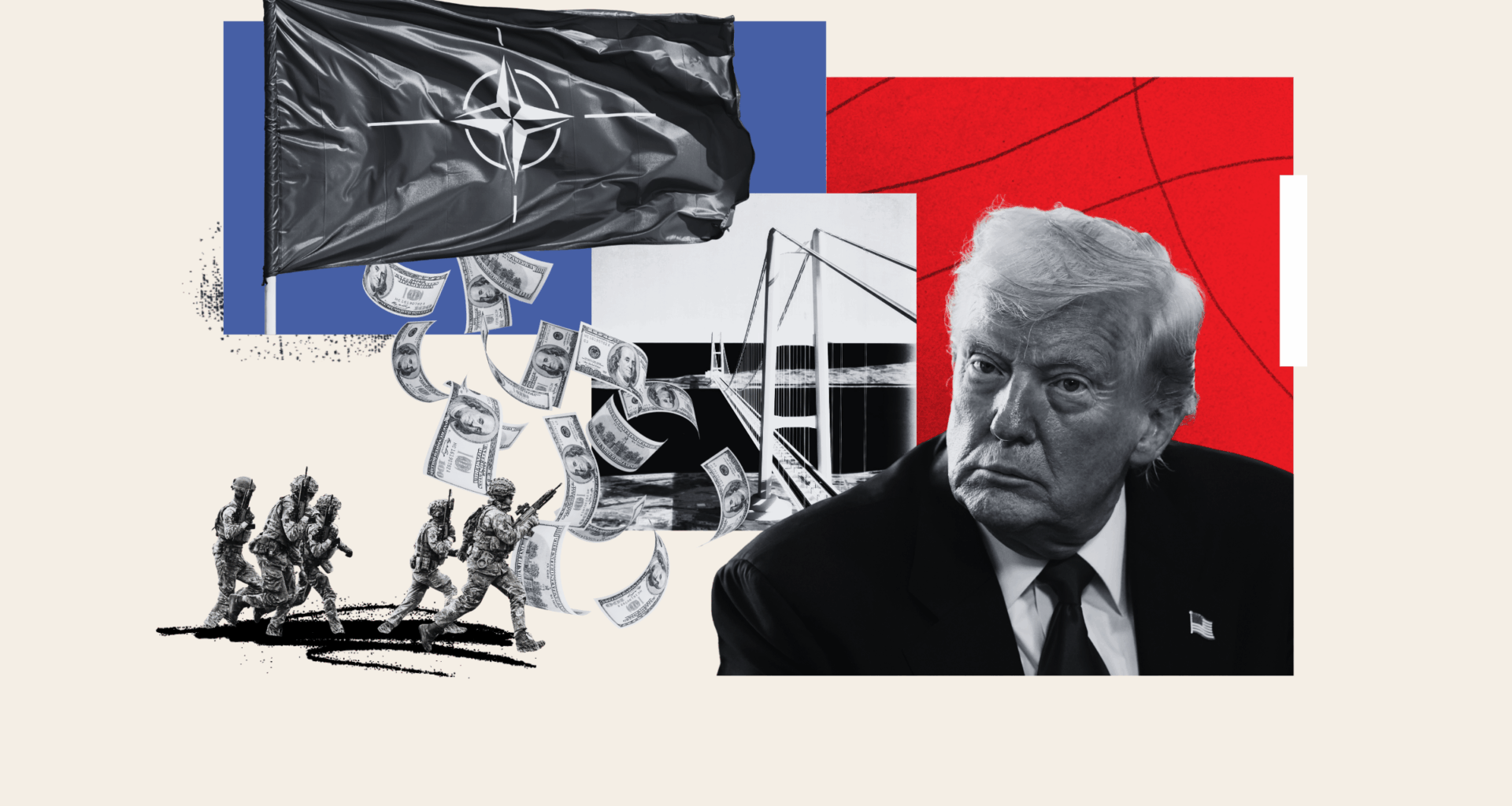President Donald Trump may have had success in convincing NATO member states to ramp up defense spending, but a key caveat allowing allies to spend a portion of this budget on “defense-related” projects has paved the way for a new wave of creative accounting that some analysts argue do not fit the bill.
The most prominent example to come under scrutiny in the wake of the summit has been Italy’s Strait of Messina Bridge, a long-planned $15.5 billion crossing to link the mainland and Sicily that Transport Minister Matteo Salvini recently dubbed “the biggest infrastructure project in the West.”
The project is under consideration to be included in Italy’s NATO expenditure, with the country arguing that it qualifies as a “security-enhancing infrastructure” on the alliance’s southern flank in the Mediterranean, according to the Associated Press.
Some, such as Nick Witney, senior policy fellow at the European Council on Foreign Relations and former chief executive of the European Defense Agency, call it “a bridge too far.”

A worker cleans the plastic of a scale design of the long-planned bridge over the Strait of Messina, designed by Pininfarina, is shown on March 24, 2004 in Rome, Italy. More than two decades later,…
A worker cleans the plastic of a scale design of the long-planned bridge over the Strait of Messina, designed by Pininfarina, is shown on March 24, 2004 in Rome, Italy. More than two decades later, the project is moving forward as a potential “defense-related” investment.
More
Franco Origlia/Getty Images
‘Military Mobility’
NATO announced in late June that member states had agreed to commit 5 percent of their GDP to their respective defense budgets amid pressure from Trump, who has long argued that the alliance was not pulling its weight on transatlantic security.
It’s a drastic increase from the 2 percent commitment previously agreed upon in 2014, when the Russia-Ukraine conflict first erupted, paving the way for Moscow’s full-scale war launched in 2022. Prior to the invasion, few NATO states had met the goal, and some are still accused of lagging now that the goalpost has been moved more than twice as far ahead.
But the new figure is broken down into two subsets, with 3.5 percent dedicated “to resource core defense requirements and to meet the NATO Capability Targets” and 1.5 percent earmarked “to inter alia protect critical infrastructure, defend networks, ensure civil preparedness and resilience, innovate, and strengthen the defence industrial base.”
Within this latter category, Witney noted that the term “military mobility” has become a “favorite ‘capability requirement'” among European Union members, the majority of which are also part of NATO, who already managed to spend 1.8 percent of their collective GDP on defense last year.
“The recent EU Defense White Paper lists it in the top seven, along with more obvious stuff like drones, air defense and cyber and electronic warfare,” Witney told Newsweek. “Funny how the Ukrainians seem to manage okay with decrepit infrastructure.”
“So, expect much investment in motorways, rail links, port facilities, et cetera,” he added.
Elie Perot, assistant professor at the Brussels School of Governance of the Vrije Universiteit Brussel, also anticipated a boom in infrastructure projects in order to help hit the mark, particularly among southern and western European nations.
He identified these NATO allies as “heavily indebted in general and therefore keen to ensure that as many existing infrastructure projects as possible can be counted towards NATO’s objectives,” as well as “situated far from Russia, which means that the security value of their transport infrastructure may automatically seem less clear than in countries closer to the main threat facing NATO, like Poland or the Baltic states.”
“No mechanism of enforcement has been foreseen when it comes to the target of 1.5 percent of GDP for ‘defense- and security-related’ investments,” Perot told Newsweek.
“This is different from the benchmark of 3.5 percent of GDP going to core defense spending, for which NATO countries will have at least to present annual plans describing ‘a credible, incremental path’ to reaching that target by 2035 – which is still a very soft enforcement mechanism, based essentially on reporting and peer-pressure,” he added.

An infographic shows defense spending as a share of GDP and distance from Moscow to the capitals of NATO members.
An infographic shows defense spending as a share of GDP and distance from Moscow to the capitals of NATO members.
AFP/Getty Images
‘Accounting Adjustments’
Projects that serve as candidates for the NATO budget are not limited to infrastructure. Some countries have sought to boost their defense figures by including even more potentially questionable items.
The United Kingdom raised eyebrows in 2016 when it began including war pensions and intelligence gathering as part of its 2 percent commitment to NATO. Spain, which continues to be among the most vocal opponents to expanding its military budget, has sought credit for expenditures such as border control, coastal surveillance and contributions to EU security missions.
Germany, Europe’s biggest economy and third-largest in the world behind the U.S. and China, has also long been reluctant toward extensive expansions of its defense budget despite a shift in rhetoric in recent years. Berlin exceeded its previous 2 percent target last year largely through a special temporary fund along with, according to Der Spiegel, expenditures tied to non-defense ministries, as well as the parliament.
Beyond this, Perot pointed out how “some NATO countries have argued that efforts to combat climate change should be taken into account, as these efforts will help reduce the impact of future natural disasters, therefore contributing to the alliance’s security in a broad sense.”
“However,” he added, “other NATO countries are likely to disagree and see this argument simply as a pretext for not actually investing more, given the large sums already spent in any case by European countries to achieve carbon neutrality.”
In addition to the apparent lack of enforcement of member states’ commitments, analysts also point to an absence of clear guidelines from NATO as to what constitutes a defense-related expense.
“NATO hasn’t issued any guidance publicly indicating what will count as defense-related and what will not,” John Deni, senior fellow with the Transatlantic Security Initiative in the Atlantic Council’s Scowcroft Center for Strategy and Security and research professor at the U.S. Army War College’s Strategic Studies Institute, told Newsweek.
“The concern is that allies have no ‘rules of the road’ on whether they can count a potentially defense-related expense toward their 5 percent commitment,” he added. “It’s not a question of whether they’ll ‘redirect’ funds—instead, the central issue is whether they should or should not get credit for a particular expense.”
Mackenzie Eaglen, senior fellow at the American Heritage Institute specializing in defense strategy, defense budgets and military readiness who also sits on the U.S. Army War College Board of Visitors, identified a similar problem.
“There are major inconsistencies in how defense expenditure is defined by and within the alliance,” Eaglen told Newsweek. “NATO uses a broad and flexible definition, counting expenditures that often fall outside traditional military budgets—including pensions, coast guards, national police forces, financial aid, and humanitarian operations.”
She argued that “these inclusions generally do not directly enhance combat power and misrepresent reported spending.”
The result, she said, led to a “hodgepodge of accounting.”

A number of analysts argue that the latest NATO defense spending targets contain ambiguities that may skirt core commitments.
A number of analysts argue that the latest NATO defense spending targets contain ambiguities that may skirt core commitments.
Newsweek Illustration/Getty
“For example, Spain’s national police force, the Civil Guard (Guardia Civil), reported a 2024 budget of approximately $3.3 billion—potentially as much as 19 percent of Spain’s NATO-reported defense expenditure—despite its primary role as a civil police agency,” Eaglen said.
“When NATO expanded the definition of acceptable military expenditures in 2018, for example,” she added, “Canada began including many additions, ranging from pensions to peacekeeping operations by the Royal Canadian Mounted Police in its NATO-reported defense budgets.”
The issue is further compounded by what Eaglen argued was a lack of transparency on the part of NATO, which “provides only topline figures with broad percentage breakdowns into personnel, equipment, infrastructure, and an ambiguous ‘other’ category, without detailing specifics of what each member’s reported budget includes.”
“The proportional spending in these broad categories varies widely across the alliance—without further breakdowns, NATO’s figures are difficult to compare with domestic defense budgets, obscuring what is actually counted as defense spending,” she said.
“This makes it unclear whether reported increases reflect real military investment or are simply accounting adjustments,” she added.
Reached for comment, Canada’s National Defense Department told Newsweek that “Canada reports defence spending according to NATO’s common definition of defence expenditure agreed by all NATO Allies.”
“Defence expenditure is defined by NATO as payments made by a national government specifically to meet the needs of its armed forces, those of Allies or of the Alliance,” the Canadian National Defense Department said. “Defence expenditures are not limited to expenditures incurred by OGDs and agencies providing support for the armed forces or ministry of defense.”
“In this respect, the Department of National Defence (DND) collects data on eligible defence-related spending by OGDs, such as the Canadian Coast Guard’s defence-related spending, in addition to its own and reports the total Canadian defence spending to NATO,” Canada’s DND added.
A spokesperson for Germany’s Federal Foreign Office referred Newsweek to NATO’s announcement at The Hague summit in June stating that “Allies will account for up to 1.5% of GDP annually to inter alia protect our critical infrastructure, defend our networks, ensure our civil preparedness and resilience, unleash innovation, and strengthen our defence industrial base.”
The spokesperson added that “Germany will, as in previous years, determine relevant expenditures in line with NATO criteria.”
‘Take the Win’
Eaglen anticipated that potential discrepancies in NATO commitments would likely draw the attention of the Trump administration, an endeavor for which she has advocated through her work at the American Heritage Institute.
“I believe the current Pentagon team will be pushing the alliance for these precise outcomes before the next summit in 2026,” Eaglen said. “Our research paper is on their radar, and it was shared with the Secretary General during his last visit.”

President Donald Trump greets NATO Secretary General Mark Rutte (L) in the Oval Office at the White House on July 14, 2025 in Washington, DC.
President Donald Trump greets NATO Secretary General Mark Rutte (L) in the Oval Office at the White House on July 14, 2025 in Washington, DC.
Kevin Dietsch/Getty Images
Yet even if stricter metrics and parameters are introduced, Todd Harrison, senior fellow also at the American Heritage Institute, argued for a more radical rethinking of the NATO defense spending scheme, in which he said there was currently “a lot of gray area about what can be included.”
“This highlights why it’s foolish to set arbitrary budget targets for NATO, and what we should be setting are force structure and modernization and readiness targets,” Harrison, who specializes on defense strategy and budgeting, told Newsweek. “What are the forces and capabilities that we want each nation to be able to contribute, regardless of how much it costs and regardless of what fraction of their economy they’re spending on it.”
“It’s just intellectually lazy to use defense spending as a percent of GDP to try to govern whether or not countries are meeting their military commitments to NATO,” he said.
And should the White House press NATO allies on their line-item budgets, Harrison pointed out that the U.S.’ own flexible definitions of defense spending, including interstate highways, may be subject to question. This is particularly the case, he argued, as the U.S. has not spent 5 percent of its own GDP on defense since the 1990s, despite having by far the world’s largest military budget.
“I think the Trump administration may be more inclined to just take the win and not question the details,” Harrison said. “If they start to question the details, then this will look more and more like what it is, which is a false commitment.”
“And then, in return,” he added, “NATO countries can fairly point out that the U.S. may not be living up to this commitment either.”
